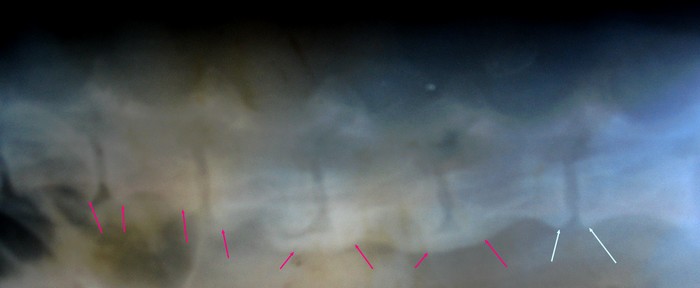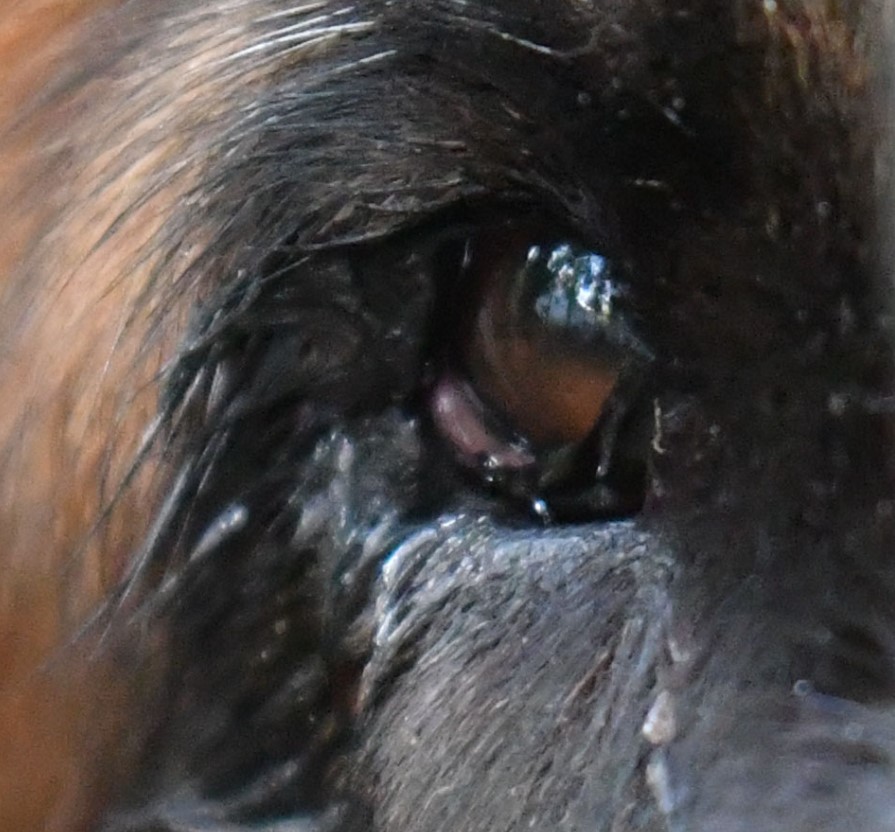HEALTH
Leonbergers are relatively healthy breed, most of health problems mentioned here are seen in older dogs if at all.

Hip Dysplasia (HD)
Hip dysplasia is a deformation of the hip joint which is not congenital defect. All puppies are born with the same looking joints. With the time about 2 months as the effect of the lack of correct pression and of bad adjustment the socket becomes shallow and the femoral head gets deformed (Blenau, 1993). Dysplasia might occur in one or both hips (Haska i in., 2011). The femoral head not touching the acetabulum tightly, moves towards its upper edge, remaining in a subluxation position. This causes improper strain and changes in the posture of the hind limbs and the development of secondary degenerative changes. This leads to symptoms such as reluctance to move and change position, unwillingness to jump and play in 5-8 month old dogs. In adult dogs, gait stiffness and weakness in the hindquarters are observed. All of these symptoms are the result of pain. However, it happens that despite the radiological picture of the severe form of dysplasia, there are no clinical symptoms and the dog moves normally (Fiszdon, 2002). According to OFA (Orthopedic Foundation for Animals), it is a developmental defect caused by many genes (polygenic) and affects 14% of individuals in the breed. (Bell i in., 2013). Environmental factors individually overlap with genetic susceptibility. (Janicki, 2012).
FCI decided to grade hips dysplasia scores in order : HD/A hips free of dysplasia, HD/B – almost normal hips, HD/C – slight hip dysplasia, HD/D – moderate hips dysplasia, HD/E – severe hips dysplasia. In Poland testing hips is not a duty but most of breeders x-ray hips of their dogs prior to breeding and ask for official scoring put into pedigree.
Using in breeding free of hips dysplasia dogs does not guarantee that offsprings will be free of this disease (Fiszdon, 2002). Another condition that can occur in a dog with dysplasia is osteoarthritis, which develops as a result of inflammation in the joint (Haska i in. 2011). Both of these diseases have similar clinical symptoms and pathogenesis (Zhou i in., 2010).
Elbow Dysplasia (ED)
Elbow dysplasia is the congenital defect inherited polygenic. It refers to a group of elbow joint deformities leading to inflammation within the elbow joint, caused by damage to the joint (Narojek i in., 2008). Most often it affects large&giant breeds of dogs. Long-lasting lameness is manifested in 4-6 month old dogs. It affects 4.8% of the Leonberger population (Bell i in., 2013).
Polineuropathy
Polineuropathy (LPN) refers to certain race-specific forms of neurological disease occurring in Leonbergers. “Poly” means a lot (many, multi etc) and “neuropathy” means that some part of the nervous system is not working properly. Damage to nerve cells disrupts feeling and movement. When muscles don’t receive the right nerve signals get weaker and prevent the dog from normal functioning. LPN comes in at least two genetically different forms that affect the longest nerves in the body. The research results indicate that there is probably a group of genetically and clinically different diseases.
In sick dogs it manifests itself as exercise intolerance and atrophy of peripheral muscles with their neuromuscular weakness. The dog may breathe noisy or have difficulty breathing due to paralysis of the muscles of the larynx. The disease is progressive and eventually leads to a point that dog is not able to carry his own weight. Laryngeal symptoms can lead to suffocation. Testing for LPN1 and LPN2, although not obligatory in Poland is performed by most breeders.
The other neurological disease in Leonbergers is leukoencephalomyelopathy, so-called LEMP occurring in Rottweiler and Leonberger dogs. LEMP is a recessively inherited neurodegenerative disorder that affects the white substance of the central nervous system (CNS).
Osteosarcoma
Osteosarcoma (osteosarcoma) may appear in large breed dogs. It is the most common type (about 80% of cases) of primary bone cancers and usually affects the skeleton of the limbs. It occurs most often in areas of intense cell division, bone epiphyses or in places of trauma. Initially it manifests with slight lameness, regressing with anti-inflammatory and analgesic drugs. The lungs are the most common site of metastasis (Anfinsen i in., 2011).
Spondylosis
Spondylosis is a degenerative disease of the spine. It develops gradually and progresses with age. It occurs usually in older dogs at around 8 years old age, although the first symptoms may appear already in a 6-years old individuals. Spondylosis is more common in the bitches than in males. As a result of vertebral degeneration, the intervertebral connection becomes stiff which results in pain, paresis and even paralysis. The main symptom is reluctance to move. It can be diagnosed on the basis of an X-ray examination (https://www.vetopedia.pl/art/spondyloza_u_psa).

The etiology of the disease may be acquired and then it usually appears with the age in older dogs. Can be also congenital (hereditary laryngoparalysis or polyneuropathy). It manifests with airway obstruction resulting from impaired laryngeal function during breathing (Kitshoff i in. 2013).

Defects of the eyelids (entropion & ectropion)
The more common entropion is condition in which the eyelid is turned inward and the eyelashes irritate the eyeball. This leads to excessive tearing of the eye, eyelid spasm and inflammation of the cornea. It is hereditary and more often affects the lateral part of the lower eyelid. The ectropion on the other hand is acondition in which the eyelid is turned outward (everted) so that its edge does not touch the eyeball. It is a less common defect, it can be temporary, related to the dog’s fatigue. Chronic leads to conjunctivitis (Garncarz i Garncarz, 2005).
Hypothyroidism
It is a systemic disease caused by disorder in thyroid gland function. Too little supply of hormones affects the metabolism of the entire body. Usually first symptoms are dermatological changes. The disease is particularly important in breeding bitches, however if properly managed they can be successfully bred (Popiel i Cekiera, 2011).
Glaucoma
Glaucoma is a degenerative eye disease in the course of which, due to increased intraocular pressure blindness occurs. Since the consequence of glaucoma is often loss of vision, it is important to correctly diagnose and implement appropriate therapy as soon as possible.
Cataract
A cataract is any clouding (loss of opacity) of the lens of the eye. The changes may affect the inside of the lens or its capsule, but over time it fills up all. In some cases, the cataract exceeds the original capsule volume – the so-called swelling cataract, leading to severe complications in the form of lens dislocations, uveitis and glaucoma (dr. wet. M. Lew). Dogs with hereditary type of cataract (HC) should not be used in breed.
Other diseases not described include: persistent pupillary membrane, osteoarthritis, juvenile osteoarthritis, enostosis, umbilical hernia, rupture of the anterior cruciate ligament (ACL), dilated cardiomyopathy, hypoadrenocorticism (Addison’s disease), detached osteochondrosis (OCD),tendency to gastric bloat and torsion (GDV), rectal fistula / rectal furunculosis, occasionally hyperthyroidism, eye disorders; PRA progressive retinal atrophy, double row of eyelashes, third eyelid eversion / cartilage defects of the third eyelid (Bell i in., 2013).
List of references
1. Anfinsen K. P., Grotmol T., Bruland O.S., Jonasdottir T. J.,2011: Breed-specific incidence rates of canine primary bone tumors — A population based survey of dogs in Norway. Can J Vet Res.; 75:209–215
2. Bell J. S., Cavanagh K. E., Tilley L. P., Smith F. W. K., 2013: Rasy psów i kotów – Przewodnik weterynaryjny. Charakterystyka ras, predylekcje do chorób, wskazania diagnostyczne i terapeutyczne. Galaktyka, 245-246
3. Blenau B., 1993: Dysplazja stawów biodrowych u psów. Magazyn weterynaryjny. 2, 3, 24-28
4. Bliss-Izberg C., Understanding LPN in Leonbergers, https://www.leohealth.org/images/lpn.pdf
5. Garncarz J., Garncarz M., 2005: Choroby powiek u małych zwierząt. Weterynaria w praktyce, maj-czerwiec, 3/2005, 52-56
6. Haska A., Gruszczyńska J., Siewruk K., 2011: Dysplazja stawów biodrowych u psa domowego (Canis familiaris). Cz. 1. wybrane metody diagnostyczne. 79, 11, 27-31
7. Janicki A.M. 2012: Pies. Dysplazja stawów biodrowych. Prawo złotej proporcji i tetralogia panewki- wartości diagnostyczne i prognostyczne. 17.
8. Kaleta T., Fiszdon K.,2002: Wybrane zagadnienia z genetyki i zachowania się psów. SGGW, Warszawa
9. Kitshoff AM1, Van Goethem B, Stegen L, Vandekerckhov P, de Rooster H. 2013: Laryngeal paralysis in dogs: an update on recent knowledge. Journal of the South African Veterinary Association 84(1): E1-E9
10. Lew M., https://marcin-lew.pl/leczenie-zacmy/
11. Narojek T., Fiszdon K., Hanysz E.,2008: Canine elbow dyspllasia in different breeds. Bull Vet Inst Pulawy 52, 169-173
12. Pikiel M., https://weterynarianews.pl/rozpoznawanie-leczenie-jaskry-psow/
13. Popiel J., Cekiera A., 2011: Niedoczynność tarczycy u psów. Magazyn weterynaryjny, 20, 170
14. Zhou Z., Sheng X., Zhang Z., Zhao K., Zhu L., Guo G., Friedenberg S. G., Hunter L. S., Vandenberg-Foels W. S., Hornbuckle W. E., Krotscheck U., Corey E, Moise N. S., Dykes N. L., Li J., Xu S., Du L., Wang Y., Sandler J., Acland G. M., Lust G., Rory J., 2010: Todhunter, Differential Genetic Regulation of Canine Hip Dysplasia and Osteoarthritis. Published online 2010 Oct 11

